You have no items in your shopping cart.
Anti-ACADS/SCAD Antibody
Catalog Number: orb669152
| Catalog Number | orb669152 |
|---|---|
| Category | Antibodies |
| Description | Anti-ACADS/SCAD Antibody. Tested in Flow Cytometry, IF, IHC, ICC, WB applications. This antibody reacts with Human, Mouse, Rat. |
| Species/Host | Rabbit |
| Clonality | Polyclonal |
| Tested applications | FC, ICC, IF, IHC, WB |
| Reactivity | Human, Mouse, Rat |
| Isotype | Rabbit IgG |
| Immunogen | A synthetic peptide corresponding to a sequence at the C-terminus of human ACADS/SCAD, identical to the related mouse and rat sequences. |
| Concentration | Adding 0.2 ml of distilled water will yield a concentration of 500 μg/ml. |
| Form/Appearance | Lyophilized |
| Conjugation | Unconjugated |
| MW | 44 kDa |
| UniProt ID | P16219 |
| Storage | Maintain refrigerated at 2-8°C for up to 2 weeks. For long term storage store at -20°C in small aliquots to prevent freeze-thaw cycles. |
| Alternative names | Fructose-bisphosphate aldolase A; Lung cancer anti Read more... |
| Note | For research use only |
| Application notes | Western blot, 0.25-0.5μg/ml, Human, Mouse, Rat Immunohistochemistry, 2-5μg/ml, Human Immunocytochemistry/Immunofluorescence, 5μg/ml, Human Flow Cytometry(Fixed), 1-3 μg/1x106 cells, Human. Add 0.2ml of distilled water will yield a concentration of 500ug/ml |
| Expiration Date | 12 months from date of receipt. |

Flow Cytometry analysis of HepG2 cells using anti-ACADS/SCAD antibody. Overlay histogram showing HepG2 cells (Blue line). To facilitate intracellular staining, cells were fixed with 4% paraformaldehyde and permeabilized with permeabilization buffer. The cells were blocked with 10% normal goat serum. And then incubated with rabbit anti-ACADS/SCAD Antibody (1 µg/1x10^6 cells) for 30 min at 20°C. DyLight®488 conjugated goat anti-rabbit IgG (5-10 µg/1x10^6 cells) was used as secondary antibody for 30 minutes at 20°C. Isotype control antibody (Green line) was rabbit IgG (1 µg/1x10^6) used under the same conditions. Unlabelled sample without incubation with primary antibody and secondary antibody (Red line) was used as a blank control.
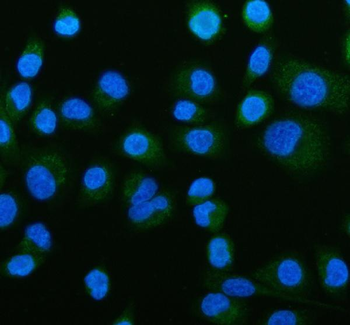
IF analysis of ACADS/SCAD using anti-ACADS/SCAD antibody. ACADS/SCAD was detected in immunocytochemical section of A549 cells. Enzyme antigen retrieval was performed using IHC enzyme antigen retrieval reagent for 15 mins. The cells were blocked with 10% goat serum. And then incubated with 5 µg/mL rabbit anti-ACADS/SCAD Antibody overnight at 4°C. DyLight®488 Conjugated Goat Anti-Rabbit IgG was used as secondary antibody at 1:500 dilution and incubated for 30 minutes at 37°C. The section was counterstained with DAPI. Visualize using a fluorescence microscope and filter sets appropriate for the label used.
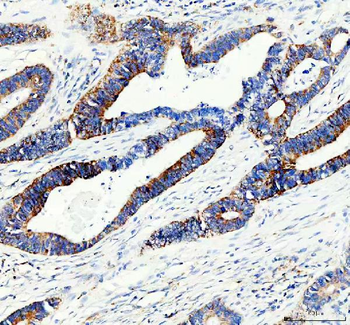
IHC analysis of ACADS/SCAD using anti-ACADS/SCAD antibody. ACADS/SCAD was detected in a paraffin-embedded section of human colon cancer tissue. Heat mediated antigen retrieval was performed in EDTA buffer (pH8.0, epitope retrieval solution). The tissue section was blocked with 10% goat serum. The tissue section was then incubated with 2 µg/ml rabbit anti-ACADS/SCAD Antibody overnight at 4°C. Peroxidase Conjugated Goat Anti-rabbit IgG was used as secondary antibody and incubated for 30 minutes at 37°C. The tissue section was developed using HRP Conjugated Rabbit IgG Super Vision Assay Kit with DAB as the chromogen.
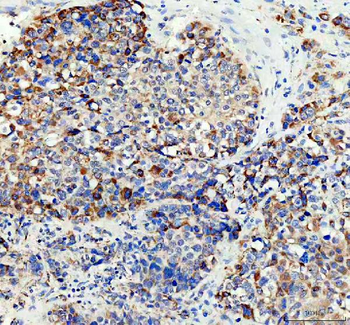
IHC analysis of ACADS/SCAD using anti-ACADS/SCAD antibody. ACADS/SCAD was detected in a paraffin-embedded section of human liver cancer tissue. Heat mediated antigen retrieval was performed in EDTA buffer (pH8.0, epitope retrieval solution). The tissue section was blocked with 10% goat serum. The tissue section was then incubated with 2 µg/ml rabbit anti-ACADS/SCAD Antibody overnight at 4°C. Peroxidase Conjugated Goat Anti-rabbit IgG was used as secondary antibody and incubated for 30 minutes at 37°C. The tissue section was developed using HRP Conjugated Rabbit IgG Super Vision Assay Kit with DAB as the chromogen.
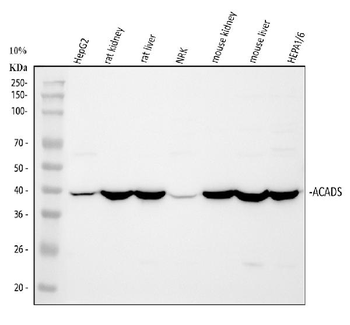
Western blot analysis of ACADS/SCAD using anti-ACADS/SCAD antibody. Electrophoresis was performed on a 5-20% SDS-PAGE gel at 70V (Stacking gel) / 90V (Resolving gel) for 2-3 hours. The sample well of each lane was loaded with 30 ug of sample under reducing conditions. Lane 1: human HepG2 whole cell lysates, Lane 2: rat kidney tissue lysates, Lane 3: rat liver tissue lysates, Lane 4: rat NRK whole cell lysates, Lane 5: mouse kidney tissue lysates, Lane 6: mouse liver tissue lysates, Lane 7: mouse HEPA1/6 whole cell lysates. After Electrophoresis, proteins were transferred to a Nitrocellulose membrane at 150 mA for 50-90 minutes. Blocked the membrane with 5% Non-fat Milk/ TBS for 1.5 hour at RT. The membrane was incubated with rabbit anti-ACADS/SCAD antigen affinity purified polyclonal antibody at 0.5 µg/mL overnight at 4°C, then washed with TBS-0.1% Tween 3 times with 5 minutes each and probed with a goat anti-rabbit IgG-HRP secondary antibody at a dilution of 1:5000 for 1.5 hour at RT. The signal is developed using an Enhanced Chemiluminescent detection (ECL) kit with Tanon 5200 system. A specific band was detected for ACADS/SCAD at approximately 44 kDa. The expected band size for ACADS/SCAD is at 44 kDa.
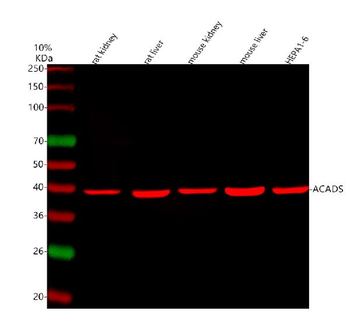
Western blot analysis of ACADS/SCAD using anti-ACADS/SCAD antibody. Electrophoresis was performed on a 5-20% SDS-PAGE gel at 70V (Stacking gel) / 90V (Resolving gel) for 2-3 hours. The sample well of each lane was loaded with 30 ug of sample under reducing conditions. Lane 1: rat kidney tissue lysates, Lane 2: rat liver tissue lysates, Lane 3: mouse kidney tissue lysates, Lane 4: mouse liver tissue lysates, Lane 5: mouse HEPA1/6 whole cell lysates. After Electrophoresis, proteins were transferred to a Nitrocellulose membrane at 150 mA for 50-90 minutes. Blocked the membrane with 5% Non-fat Milk/ TBS for 1.5 hour at RT. The membrane was incubated with rabbit anti-ACADS/SCAD antigen affinity purified polyclonal antibody at 0.5 µg/mL overnight at 4°C, then washed with TBS-0.1% Tween 3 times with 5 minutes each and probed with a goat anti-rabbit IgG-DyLight 647 Conjugated secondary antibody at a dilution of 1:5000 for 1.5 hour at RT. The signal is developed using an Enhanced Chemiluminescent detection (ECL) kit with Tanon 5200 system. A specific band was detected for ACADS/SCAD at approximately 44 kDa. The expected band size for ACADS/SCAD is at 44 kDa.
Anti-ACADS / SCAD Rabbit Monoclonal Antibody [orb1147390]
IHC, IP, WB
Human, Mouse, Rat
Rabbit
Monoclonal
Unconjugated
Anti-ACADS/SCAD Antibody [orb2604741]
FC, ICC, IF, IHC, WB
Human, Mouse, Rat
Rabbit
Polyclonal
iFluor647
100 μgAnti-ACADS/SCAD Antibody [orb2604742]
FC, ICC, IF, IHC, WB
Human, Mouse, Rat
Rabbit
Polyclonal
PE
100 μgAnti-ACADS/SCAD Antibody [orb2604743]
FC, ICC, IF, IHC, WB
Human, Mouse, Rat
Rabbit
Polyclonal
APC
100 μgAnti-ACADS/SCAD Antibody [orb2604744]
FC, ICC, IF, IHC, WB
Human, Mouse, Rat
Rabbit
Polyclonal
HRP
100 μg




